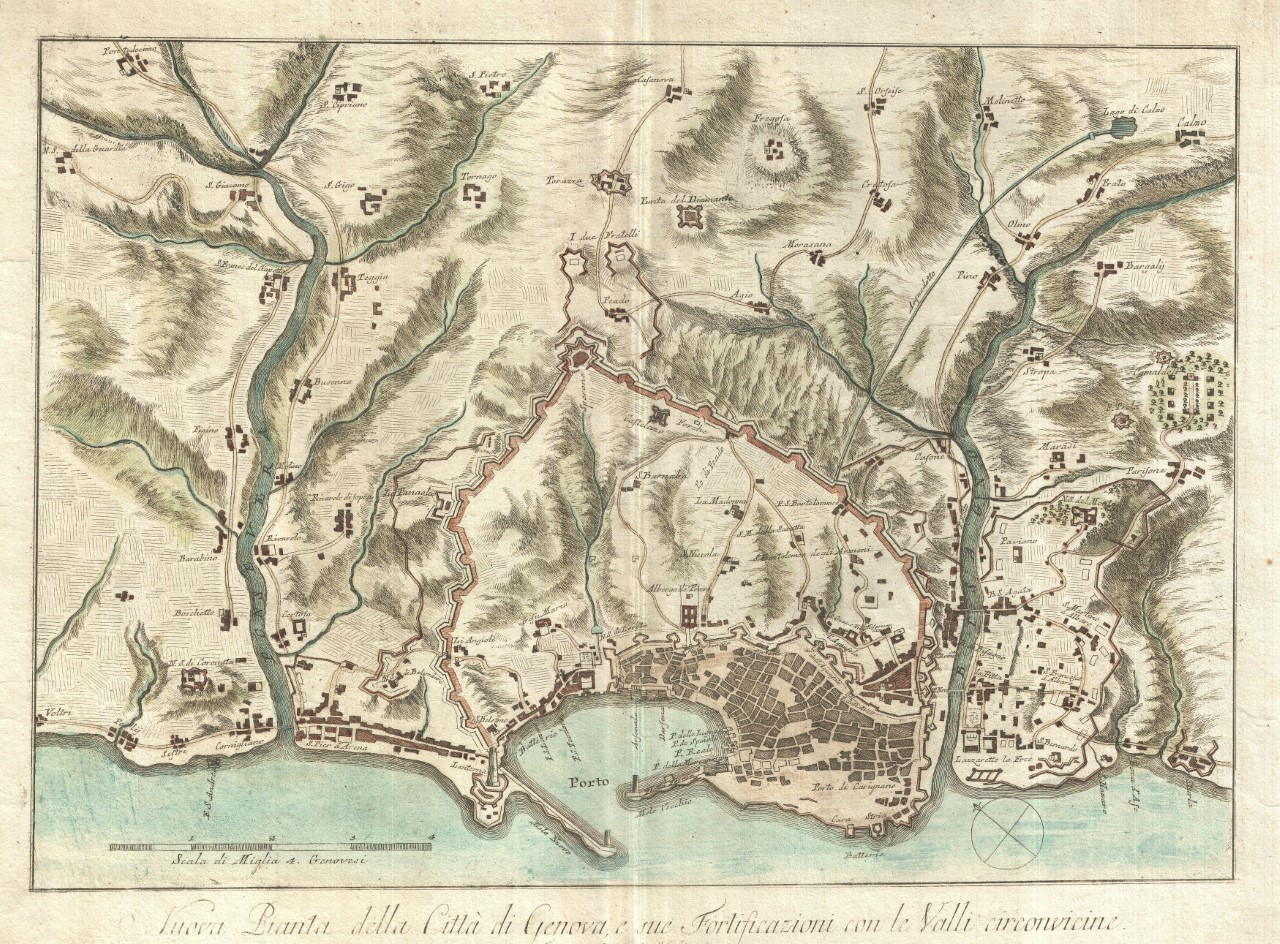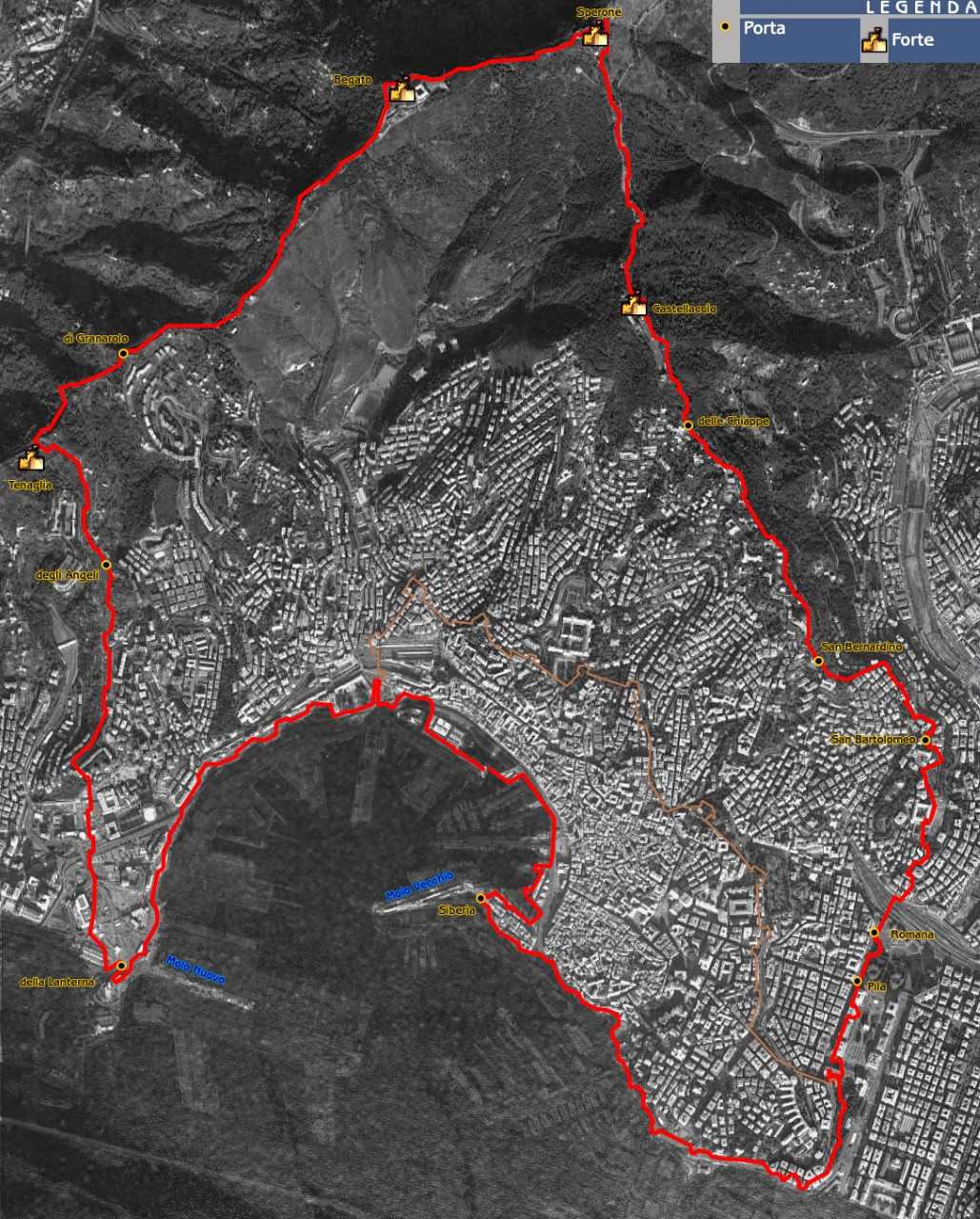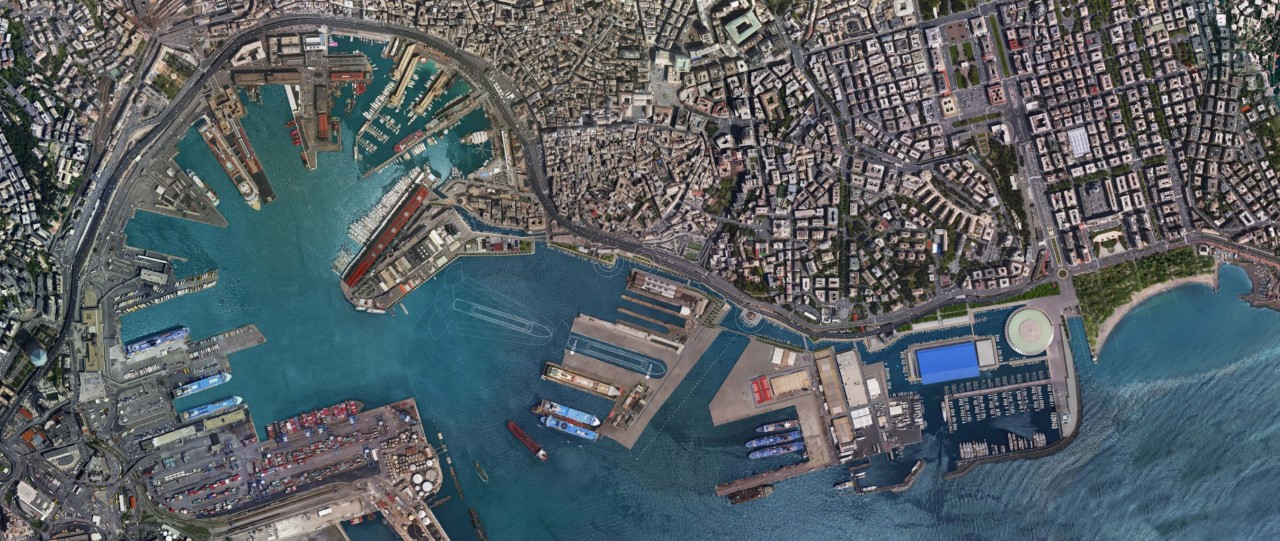Beatrice Moretti
After Genoa’s intense urban transformation at the turn of the 1990s and 2000s, the Italian port city has experienced a long slowdown in urban transformation operations. In recent years, however, new perspectives have been consolidated, foreshadowing a reinterpretation of the port-city landscape. In this process, the disclosure - almost as if it had been hidden for decades - of the historical heritage running along the border between city and port emerges as a crucial element. In the case of the far eastern part of Genoa, it is characterized by the latent presence of the ancient 16th-century walls in the area of the Bisagno river mouth. In this blog, PhD Architect Beatrice Moretti investigates how this extraordinary heritage is being revealed thanks to the implementation of the Waterfront di Levante project.

All phases of Genoa’s urban development are characterized by the progressive expansion of its city walls towards limits marked by different heights. By integrating their profile into the gradually built-up areas, the defensive walls remain as an evocative background and monumental testimony of the city’s historical and cultural value (Dellepiane, 1984). As early as 1100, with Barbarossa’s Walls encircling the historic center, Genoa built several defensive walls. At the end of the 13th century, these walls were extended to include protective maritime works. The extensions continued to the north and west in both the 14th and 16th centuries, when modern fortifications were implemented: the Land Walls with the new bastions, and the Sea Walls with the new sea gates. It was between 1626 and 1639, however, that the last and greatest of the city walls, the New Walls, were completed. They extended for a length of almost twenty kilometers, of which about seven along the coastline, from the Lanterna promontory to the mouth of the Bisagno river.

This far eastern portion of the still existing walls is now the site of a large urban regeneration project called the Waterfront di Levante (WdL). Derived from a proposal originally named Blueprint, donated to the city of Genoa in 2013 by architect Renzo Piano and his architectural firm Renzo Piano Building Workshop (RPBW),1 the WdL project is structured according to an overall design aimed at developing and harmonizing the urban and industrial activities present in the eastern areas of the port of Genoa.
This strip of land along the sea demarcates the city and parts of the operational port occupied by ship repair industries, dry docks and areas dedicated to pleasure and nautical sports, as well as, at the eastern end, the 1960s fair area with several pavilions almost entirely used for temporary functions and events with large attendance. Due to the lack of space, this area presents widespread problems in the management of logistics and port flows, urban accessibility and, in general, difficult coexistence with functions that are not always compatible with industrial production. In addition, the abandonment of some buildings has put the trade fair sector in crisis, requiring an update of its position in the general economy of the city.
The overarching aim of the WdL project is to enhance the relationship between the city and the sea in terms of social and economic attractiveness, by exploiting the porosity and flexibility of the common border and by connecting the waterfront in a west-east direction. The new waterfront is in fact the completion of works carried out for the 1992 Colombian Expo, with which the city converted large decommissioned port areas into a functional programme with an urban, cultural and touristic vocation (Giontoni, 2020).

This west-east connection is achieved through the construction of a navigable “urban canal”, which runs along the perimeter of the ancient walls at the level of the quay and adjacent to the highway. The waterway will be obtained by excavating portions of the existing piers under the city walls. This action will provide a new Waterfront Urban Park of approximately 16,000 sqm along the waterfront, and connected vertically to a panoramic lift with landings above and below the historic walls. The new navigable waterway has a double purpose: on the one hand, it will detach the port to give it more autonomy and, on the other, it will create a continuous public promenade functioning as a real interface between the two shores. From a mobility point of view, the WdL project is tackling an extremely complex situation due to the overlapping of public, private, urban and port circulations. In this regard, the project plans to replace the elevated highway with an urban path which, located at the level of the quay, will run parallel to the navigable water channel.
Covering approximately 83,300 sqm of public areas, the WdL project envisages a part for receptive and residential buildings (15,000 sqm), an area dedicated to the service sector (24,000 sqm) and two districts, of 7,000 sqm each, for commercial and multipurpose fairgrounds. In addition to the construction of the Waterfront Urban Park and the marina along the navigable channel, the project also envisages a new urban beach in front of Piazzale Kennedy, with a view to re-naturalizing and making new public use of the Bisagno estuary. Parallel to this, on the port side, the WdL project proposes the construction of a double operational peninsula, the “Factory of the Port”, which will be reached thanks to the realization of four new bridges crossing the new navigable channel. In this way, the new channel acquires autonomy and will provide optimization to the industrial sectors of the port that are being extended towards the sea.

Today, the project is underway, especially in the eastern areas where, since 2019, the Municipality has started intense demolition works of the existing pavilions in order to free up the area.2 In this framework, it is also important to underline that the WdL project falls within areas with a heterogeneous ownership layout (Lombardini, Moretti and Pitanti, 2021a). The portion to the east, from Piazzale Kennedy to the areas adjacent to the former Ansaldo-Nira building, belongs to the Municipality, while the portion that connects to the Porto Antico is port territory, with the exception of a part of the road system at the interface with the city, which only partially falls within the urban area. The multiplicity of owners and investors further highlights the complexity of implementing the operation in light of the unitary realization of the design (Lombardini, Moretti and Pitanti, 2021b).
Through the WdL project, Genoa is experimenting with new tactics in the management of port-city border areas. The water works, in particular the realization of the navigable channel, intervene directly on the porous edge through its design. With the creation of a double bank, the urban one and the port one, the edge acquires depth and a mixed functionality, and new activities join the rich pre-existing heritage. In this process, the New Walls of Genoa, which still exist, are subjected to a process of revealing. They are freed from the superstructures that have hidden them for decades and, thanks to the opening of the water channel, obtain new space along with new visibility.
By giving new meaning to water as an infrastructural space, and to the complex relationship between the port and the city (Breś and Krośnicka, 2021), the WdL project represents the multiple configurations that the border between city and port can display. In this project, the port is not decommissioned and delocalized to make room for the city - as was mostly the case in the conversion of port areas to urban use at the end of the 20th century - but instead remains active, strengthening its work areas and streamlining its accessibility. The city front, on the other hand, re-establishes its relationship with the water and the employability of a new continuous coastal path.
In this way, the city and the port not only coexist, but are able to attribute a strategic and non-residual role to their shared border, which becomes the design skeleton that activates the whole operation. Such tactics of border design, together with the revelation of forgotten historical heritage, are motivated by the port city’s porosity: a peculiar character of these contexts, useful to conceptualize the multiple ways in which the spaces and institutions of ports, cities, and neighboring areas intersect (Hein, 2021). More than an edge, then, in this portion of Genoa, the port-city intersection creates a threshold space (Moretti, 2020), which has been shifted, opened up, doubled and thickened to become an infrastructure of physical and symbolic crossing.
Acknowledgement
Beatrice Moretti is a PhD Architect, Research Fellow and Lecturer at the University of Genoa, Italy. From 2010 to 2015, she was Research Fellow at Genoa Urban Lab and at Genoa Port Authority. In 2022, she is scientific consultant for AIVP within the MAGPIE H2020 Smart Green Ports Project. Moretti is author of the books “Un colle, un transatlantico, un nome: Tre storie sul porto di Genova” (Sagep, 2018), “Beyond the Port City: The Condition of Portuality and the Threshold Concept” (JOVIS, 2020) and “A Landscape Infra-structure Research: Roma Tuscolana Pilot Project” (ListLab, 2022, with G. Tucci).
This blog was peer-reviewed by members of the PortCityFutures community, and edited by the PortCityFutures editorial team: Carola Hein, Hilde Sennema and Vincent Baptist.
Notes
1 The recipients of the donation were local public bodies, in particular the Liguria Region, the Municipality of Genoa and the Western Ligurian Sea Port System Authority. See also the following source: Waterfront di Levante, Act of donation by RPBW (2017) https://smart.comune.genova.it/node/8191.
2 See the following sources: Project PUO DST 20 settore 2 “Fiera-Kennedy” (2019), http://www.comune.genova.it/content/deliberazione-della-giunta-comunale-puo-waterfront; and Renzo Piano's new Guidelines (architectural aspects) (2021), https://smart.comune.genova.it/comunicati-stampa-articoli/waterfront-di-levante-nuove-linee-guida-di-renzo-piano-un-quartiere.
References
Breś, J., and Krośnicka, K.A., (2021). “Evolution of Edges and Porosity of Urban Blue Spaces: A Case Study of Gdańsk”. Urban Planning 6(3), 90-104.
Dellepiane, R., (1984). Mura e fortificazioni di Genova. Nuova Editrice Genovese.
Giontoni, B., (2020). Le trasformazioni di Genova: Piani e interventi urbanistici dagli anni Settanta ad oggi. Erga.
Hein, C. (ed.), (2021). Planning for Porosity: Exploring Port City Development through the Lens of Boundaries and Flows, Urban Planning 6(3).
Lombardini, G., Moretti, B. and Pitanti, M., (2021a). “Possedere e trasformare: Il ruolo della proprietà pubblica nelle grandi operazioni di trasformazione urbana a Genova”. In Una geografia delle politiche urbane tra possesso e governo: Sfide e opportunità nella transizione, edited by Perrone, C., Masiani, B. and Tosi, F., Urban@it - Centro nazionale di studi per le politiche urbane, pp. 81-97.
Lombardini, G., Moretti, B. and Pitanti, M., (2021b). “The Role of the Public Municipality in Urban Regeneration: The Case of Genoa”. In REAL CORP. The 26th International Conference on Urban Planning, Regional Development and Information Society, BOKU University, pp. 919-933.
Moretti, B., (2020). Beyond the Port City: The Condition of Portuality and the Threshold Concept. JOVIS.
